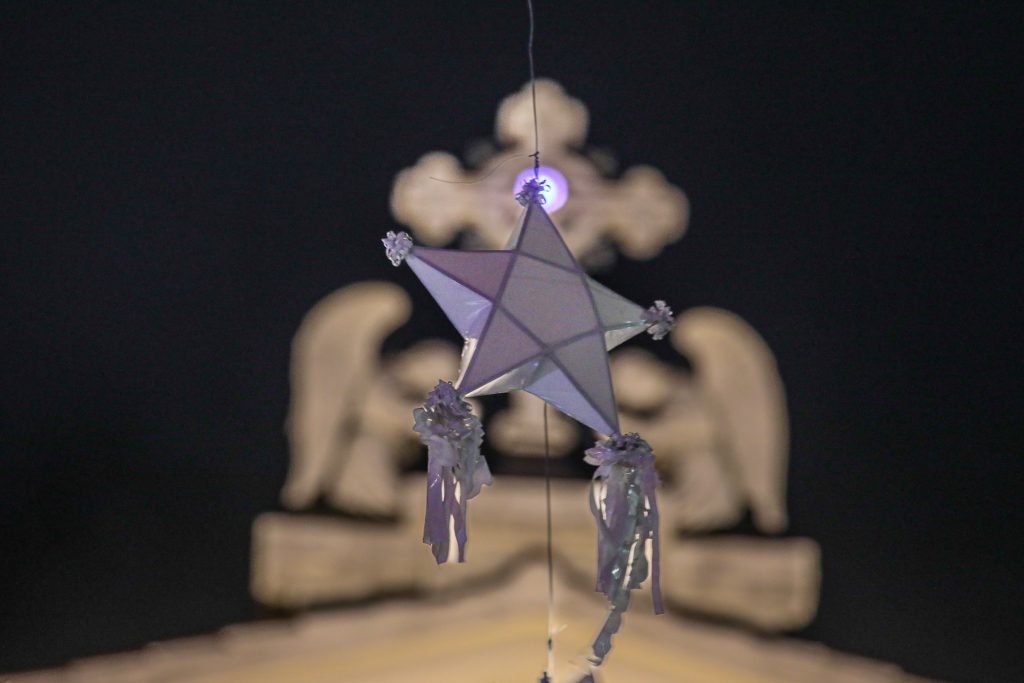The “Misa de Gallo,” or “Mass of the Rooster,” started in the Philippines with the arrival of religious missionaries from Mexico in the mid-1600s.
As the story goes, priests agreed to hold predawn Masses, when roosters start to crow, so that farmers and fishermen could attend to their religious obligations before setting off to work.
The flickering light of candles in “parols,” or Christmas lanterns, that hang outside the humble huts along the road to the church offer light to the early-morning churchgoers.
The pre-dawn Mass is announced by the ringing of church bells. In some rural communities, a brass band plays Christmas music while going around town an hour before the start of the celebration.
According to stories, some parish priests would even go around knocking on doors to wake the faithful and gather them to attend the Mass.
The “Misa de Gallo” became an opportunity for the early missionaries to evangelize the people.
It became a venue to explain the meaning of Christmas and how to prepare for the coming of the Messiah.


Franciscan priest Andres Rañoa Jr. said that from the onset, the “Simbang Gabi” was “a catechizing and evangelizing moment, when rich and poor, men and women, children and elderly, came together as a community waiting for the coming of the Lord and rejoicing in the promise of the Messiah.”
There was a time, however, that the “Misa de Gallo” was not celebrated for nine years, from 1680 to 1689, due to a Vatican decree that was implemented by Archbishop Felipe Pardo of Manila.
The decree, which was also implemented in Spain, the Azores, and Mexico, stemmed from the habit of churchgoers and choirs of singing in their native tongue during Mass.
At the time, the singing in the vernacular was only allowed at the start and the end of the Mass. The singing of Christmas songs during Mass was seen as irregular.
After the death of Archbishop Pardo, the priests resumed the celebration of the “Misa de Gallo” in the Philippines with the exception of the Discalced Franciscans.


The “Misa de Gallo” continued to be celebrated even during the Spanish-American War in the Philippines at the turn of the 19th century.
It has since became a cultural tradition and the signal of the start of the local Christmas festivities.
Father Rañoa said the religious meaning “got relegated to the background as people went to church not so much to prepare themselves spiritually for the coming of Christ, but to meet families and friends, boyfriends and girlfriends, and socialize after Mass.”
“This was how [‘Misa de Gallo’] became a form of popular religiosity,” said the priest.
The “Misa de Gallo” usually begins at four o’clock in the morning.
Pope Sixtus V ordered that it would be celebrated before sunrise because it is the harvest season and farmers needed to be in the fields right after the liturgy.
Filipinos celebrate the Mass with great solemnity and the “Gloria” is sung, which is otherwise forbidden the rest of the day because it is still the Advent season in the Church calendar.
In 1953, the First Plenary Council of the Philippines made a formal petition to Rome to continue with the practice of the “Misa de Gallo.”
The “Papal Indult,” or privilege, was granted with the following conditions: The nine days preceding the Nativity of our Lord starts on December 16, with solemn votive Mass, but only once a day with great solemnity and with a big attendance of the faithful.
On March 24, 1961, the Vatican granted the continuation of the Indult for another five years.


Since then, everywhere in the Philippines, the “Misa del Gallo” is celebrated with great solemnity.
Liturgically, the “Misa de Gallo” is a Mass celebrated early in the morning in honor of the Virgin Mary “in which the interplay of light and darkness convey the meaning of Advent.”
Pope Sixtus V, however, added the following intentions: (1) the glorification and exaltation of the Holy Mother Church; (2) the propagation of the Holy Catholic Faith; and (3) the preservation of the newly baptized natives in the “True Faith.”
With Vatican II, the original intention of the celebration was revisited in the context of the modern times and the needs of modern society.
Churches in the national capital Manila started celebrating the Masses in the evening to allow more people to participate in the novena, thus the “Misa de Gallo” became known as the “Simbang Gabi,” or “Evening Mass.”
Today, the novena Mass, whether celebrated traditionally at dawn or in the early evening, is popularly known as “Simbang Gabi,” which is also called “Misa de Aguinaldo (gift mass).”
In many parts of the Philippines, the term “Misa de Gallo” now only refers to the last Mass on Christmas Eve. In Zamboanga, the series of Masses before Christmas is called “Misa de los Pastores.”


The “Simbang Gabi” from the 15th of December until the 23rd is most of the time erroneously described as “anticipated Simbang Gabi.”
“Anticipated Masses” are, however, only applicable for Sundays and Holy Days of Obligation.
To this day, Filipinos continue to flock to churches starting December 16 to usher in Christmas, the birth of the Child Jesus.
Folk belief states that if a devotee completes all nine days of the “Simbang Gabi,” God will grant a request made as part of the novena.


